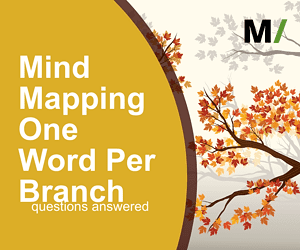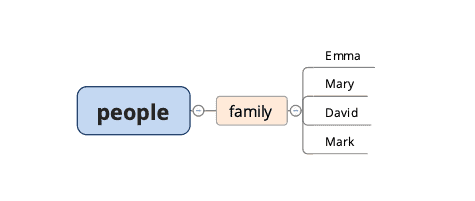A traditional mind map should follow guidelines or rules. These rules help to create a powerful mind map. One of the rules tells us to use one word per branch.
People find this rule often very difficult. How can you capture enough detail and information using one word? What happens is that many maps I see use more than one word per branch. Let’s discuss if this is a problem or a blessing.

The Reasoning Behind the One Word Rule
I am sure there has to a good reason why we should only use one word per branch. And yes, there is! Have a look at the following example of a map that I often receive. People create this and tell me mind mapping doesn’t make things clearer for them.

This map can work for you, but often it gets too big to manage or view. I sometimes receive maps that don’t use a few words per branch. These maps literally have sentences per branch totalling 15 to 25 words each! You can imagine what happens when you try to read or even study these maps!
When you change the map to use one word, this is the result:

This is a much clearer overview. I know that you don’t know who is younger or a brother. Is that relevant information for you or the reader? If not, don’t put it in the map.
Tony Buzan uses in one of his videos the example of a map based on himself. When you use “Tony Buzan” in the map instead of “Buzan” and then “Tony” you make the map rigid, less flexible.
He says that when you use seperate words, other information about the name “Buzan” can be added (other people, history, etc.).
Of course he is right about this. My question would be… do you need all that information in your map at that location?
Your brain loves to create associations. Unfortunately a lot of people use this ‘freedom’ to get distracted. My take on this is that one word is good in certain situations.
I would use one word when I need to generate ideas, brainstorm, develop a story, outline a idea. Freedom is wonderful in these situations.
When it comes to studying a topic or working on a project I want to limit this freedom near the end of my studies. I do this by focusing more in my map.
How would we use this when mind mapping? Here is my take on this:
How To Use the One Word Per Branch Rule in Real Life
First of all, let me start by saying that the One Word per branch rule is smart advice. I would not make this a rule. It is smart advice to limit your notes in general. I love the minimalist approach to mind mapping. Having said that, I don’t mind using more than one word. This is because it can help clarify. For instance when you add a definition or a rule you can’t use one word only.
Have a look at the example below.
Which one is clearer? The way I write about Emma her workplace or David his workplace?

Creating a map like I did for Emma her workplace takes more words and more branches. It is not clearer than the short line I wrote for David.
Which one you use depends on your goal. Do you want to have an open-ended or a focused map?
Do you want to add more information to the map? Mapping out the workplace of Emma may be better. Is it an end-point in your map and you need no further details added to it? You want to use the Mark method.
My advice to you is this.
Do you want to freely associate, brainstorm, capture your ideas, or take notes from conversations? Create an open-ended map with lots of ways to add more information!
A focused map is probably better when you have a well defined topic like a project, study course, goal. In this map you can use more than one word per branch. Still, you always want to minimize the number of words.
HINT: Use the smallest number of words by using the “Google Technique”. What are the fewest words you would use in Google to find your answer? Use those words in your map
There is another map that I call the Lazy map. You often only use this as a starting point for the other two maps. Here is how you use this:
You start by writing as much as possible in the map. Yes, even when you have to use sentences, that is fine.
I use this when I go through my (study) books. Often I write the full headlines of paragraphs in the map! (please don’t tell other people I do this).
The reason I do this is that I don’t want to waste too much time on thinking about the information. I simply add what is relevant.
Afterward, I reduce the number of words to a more focused map.
There you have it, the answer to using One Word per branch!
Final Thoughts on One Word per Branch
In general, it is a good idea to use few words per branch. One word is not always needed or possible. Too many words is creating too much noise. There has to be a balance between the result and the time you put into making the map.
Remember, a mind map is a tool. A very useful tool, but again… still a tool. You don’t want to spend too much time creating the map. Your goal is to create a map you benefit from.
Here’s how I would create the map with as few words as possible.
- Start wide, use as many words as possible
- After this first draft, you simplify the map. Be a minimalist!
- Use the map (most people don’t do this)!
- When needed, remove or add words per branch. Don’t be afraid to add new branches to your map.
When you work like this, you never go wrong. You may not create the perfect mind map according to the mind mapping rules. That’s OK if the map helps you to achieve your goal.
Always remember, it is not about the number of words you use! As long as your map helps you to organize your information in the best way possible, that is what counts!
If you have any questions about this or any other topics, leave a message in the comments or contact me.


